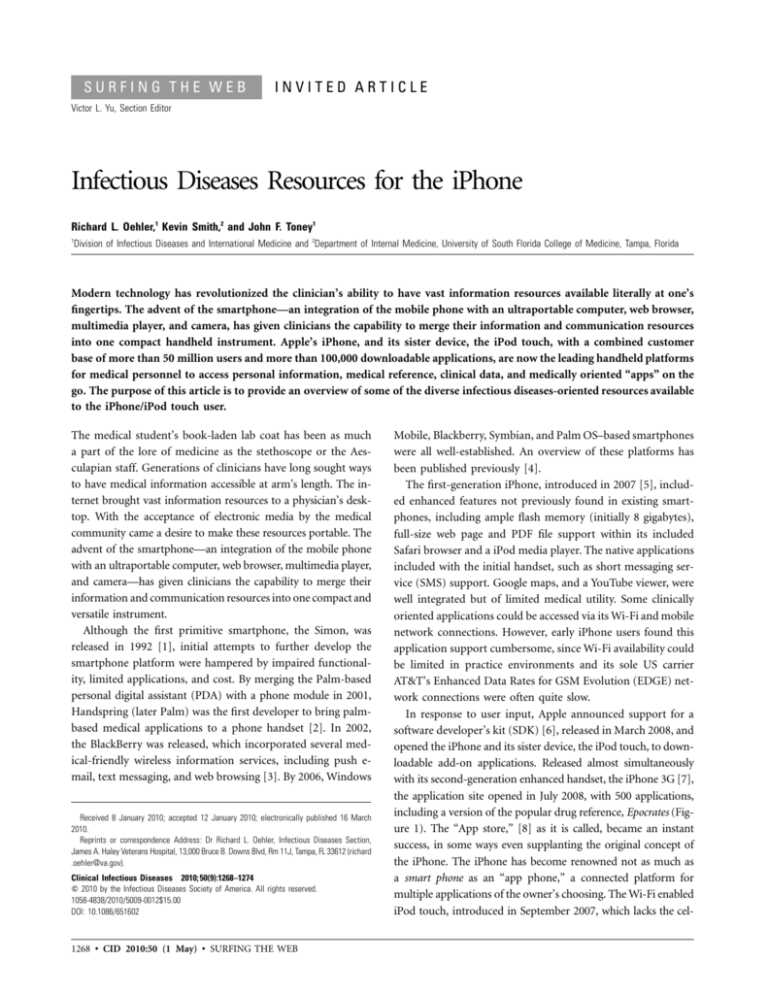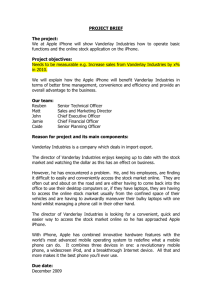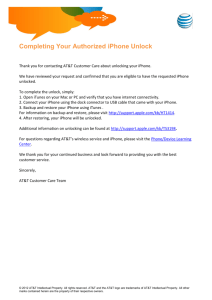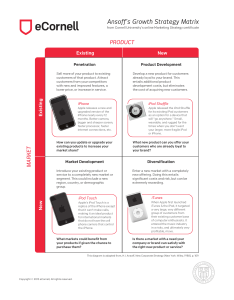
SURFING THE WEB
INVITED ARTICLE
Victor L. Yu, Section Editor
Infectious Diseases Resources for the iPhone
Richard L. Oehler,1 Kevin Smith,2 and John F. Toney1
1
Division of Infectious Diseases and International Medicine and 2Department of Internal Medicine, University of South Florida College of Medicine, Tampa, Florida
Modern technology has revolutionized the clinician’s ability to have vast information resources available literally at one’s
fingertips. The advent of the smartphone—an integration of the mobile phone with an ultraportable computer, web browser,
multimedia player, and camera, has given clinicians the capability to merge their information and communication resources
into one compact handheld instrument. Apple’s iPhone, and its sister device, the iPod touch, with a combined customer
base of more than 50 million users and more than 100,000 downloadable applications, are now the leading handheld platforms
for medical personnel to access personal information, medical reference, clinical data, and medically oriented “apps” on the
go. The purpose of this article is to provide an overview of some of the diverse infectious diseases-oriented resources available
to the iPhone/iPod touch user.
The medical student’s book-laden lab coat has been as much
a part of the lore of medicine as the stethoscope or the Aesculapian staff. Generations of clinicians have long sought ways
to have medical information accessible at arm’s length. The internet brought vast information resources to a physician’s desktop. With the acceptance of electronic media by the medical
community came a desire to make these resources portable. The
advent of the smartphone—an integration of the mobile phone
with an ultraportable computer, web browser, multimedia player,
and camera—has given clinicians the capability to merge their
information and communication resources into one compact and
versatile instrument.
Although the first primitive smartphone, the Simon, was
released in 1992 [1], initial attempts to further develop the
smartphone platform were hampered by impaired functionality, limited applications, and cost. By merging the Palm-based
personal digital assistant (PDA) with a phone module in 2001,
Handspring (later Palm) was the first developer to bring palmbased medical applications to a phone handset [2]. In 2002,
the BlackBerry was released, which incorporated several medical-friendly wireless information services, including push email, text messaging, and web browsing [3]. By 2006, Windows
Received 8 January 2010; accepted 12 January 2010; electronically published 16 March
2010.
Reprints or correspondence Address: Dr Richard L. Oehler, Infectious Diseases Section,
James A. Haley Veterans Hospital, 13,000 Bruce B. Downs Blvd, Rm 11J, Tampa, FL 33612 (richard
.oehler@va.gov).
Clinical Infectious Diseases 2010; 50(9):1268–1274
2010 by the Infectious Diseases Society of America. All rights reserved.
1058-4838/2010/5009-0012$15.00
DOI: 10.1086/651602
1268 • CID 2010:50 (1 May) • SURFING THE WEB
Mobile, Blackberry, Symbian, and Palm OS–based smartphones
were all well-established. An overview of these platforms has
been published previously [4].
The first-generation iPhone, introduced in 2007 [5], included enhanced features not previously found in existing smartphones, including ample flash memory (initially 8 gigabytes),
full-size web page and PDF file support within its included
Safari browser and a iPod media player. The native applications
included with the initial handset, such as short messaging service (SMS) support. Google maps, and a YouTube viewer, were
well integrated but of limited medical utility. Some clinically
oriented applications could be accessed via its Wi-Fi and mobile
network connections. However, early iPhone users found this
application support cumbersome, since Wi-Fi availability could
be limited in practice environments and its sole US carrier
AT&T’s Enhanced Data Rates for GSM Evolution (EDGE) network connections were often quite slow.
In response to user input, Apple announced support for a
software developer’s kit (SDK) [6], released in March 2008, and
opened the iPhone and its sister device, the iPod touch, to downloadable add-on applications. Released almost simultaneously
with its second-generation enhanced handset, the iPhone 3G [7],
the application site opened in July 2008, with 500 applications,
including a version of the popular drug reference, Epocrates (Figure 1). The “App store,” [8] as it is called, became an instant
success, in some ways even supplanting the original concept of
the iPhone. The iPhone has become renowned not as much as
a smart phone as an “app phone,” a connected platform for
multiple applications of the owner’s choosing. The Wi-Fi enabled
iPod touch, introduced in September 2007, which lacks the cel-
Figure 1. Drug reference apps for the iPhone/iPod touch: A, Epocrates mobile reference; B, Medscape suite; C, FDA Drugs; D, Skyscape’s Rx Drugs.
lular network support, camera, and (for earlier models) microphone of its larger sibling, has also been utilized by clinicians
who wish to access iPhone applications without the need for a
mobile contract. As of early 2010, more than 100,000 applications
were available on the App store, and more than 3 billion applications had been downloaded. Applications for the iPhone now
have a potential combined customer base of more than 50 million
iPhone/iPod touch users [9, 10]. A new device, the iPad, joined
Apple’s lineup of mobile devices in early 2010 and is compatible
with most iPhone apps, though in a tablet-sized format.
With its growing adoption in the medical community, thirdparty developers of medical software have responded by making
a number of paid and free applications available for medical
iPhone users. Many of these applications are suited to infectious
diseases clinicians. Other ID-oriented educational tools are also
available that take advantage of the iPhone’s multimedia capabilities. The purpose of this article is to provide an overview
of some of the diverse infectious diseases–oriented resources
available to the iPhone/iPod touch user.
MULTIMEDIA DOWNLOADS
A growing number of medical educational resources are now
being made available via multimedia audio (MP3) and video
(MP4) files. Whereas audio cassettes and VHS tapes were once
the formats of choice for distributing board reviews, media
reproductions of conference sessions, and continuing medical
education (CME) programs, vendors have for several years
begun to make their products accessible through an iPod,
MP3 or other multimedia player. In many cases, educational providers (eg, Sound Images; http://www.siattend.com)
have permitted their content to be accessible via downloads.
Audible.com, one of the largest online audiobook and podcast
distributors, also offers medically oriented podcast and au-
dible book titles available for download. Multimedia files can
be played through the iPhone or iPod touch’s built in iPod
function.
YouTube (http://www.youtube.com), the online video sharing site now owned by Google, offers a growing collection of
medical and infectious diseases–related content available via
the iPhone’s YouTube application. Streaming YouTube videos
play best through a Wi-Fi connection, although mobile 3G connections are also possible.
Like YouTube, podcasts also permit the review of audio and
video content via the video iPod function, but offer the advantage that they can be pre-downloaded to the device and then reviewed without an internet connection. Infectious disease–oriented podcast sites (eg, http://www.idpodcasts.net) permit content to be downloaded to a desktop computer for uploading to
an iPod or iPhone or can be streamed directly through the
device’s Safari browser.
The iTunes Store is now the largest legal online media retailer
in the world [11], having sold over 6 billion songs since its
inception in 2004. With over 70% of the online market, compatibility with iTunes has even been sought by other smartphone manufacturers (ie, the Palm Pre) [12] who recognize
the importance of access to a user’s iTunes library. The iTunes
store’s podcast site includes numerous medical, public health
(eg, Johns Hopkins and the Centers for Disease Control and
Prevention [CDC]), academic (eg, National Jewish Health), and
scientifically oriented (eg, Lancet Infectious Diseases) podcasts.
In an attempt to improve access and to promote the exchange
of educational podcast material, the iTunes Store established
iTunes U in 2007 [13]. This service provides colleges or universities with a personal site in the iTunes store for distributing
multimedia downloads, which may include course lectures,
demonstrations, extracurricular activities, or campus inforSURFING THE WEB • CID 2010:50 (1 May) • 1269
mation. Although this format shows promise as a medium for
distributing medically oriented content, few academic universities or public health institutions have yet to utilize it.
As diverse as these information resources are within the
iPhone/iPod touch handset, it is the adoption of the online
application service, or “App” store, by medical users, that has
proven to be the most transforming as a pocket resource. Medical content providers have made accessible almost every major
electronic reference and/or educational volume via the platform’s touch-screen interface. Content has been provided
through 1 of 3 models, via a free download, through a onetime
purchase price, or as a periodic subscription (Table 1).
INFECTIOUS DISEASE APPLICATIONS
FOR THE iPHONE
Applications useful to the ID clinician are available in the form
of popular reference guides, review materials, drug information databases (Figure 1), medical news sources, and medical
calculators. Reference guides (eg, The Merck Manual) [14]
are available as stand-alone applications. Some popular titles
are available through subscription with Skyscape (http://www
.Skyscape.com), a large mobile medical reference provider. Applications for US Medical Licensing Examination (USMLE) microbiology review from Lange, Current, and PreTest are popular among students. Several drug information databases (eg,
Epocrates) can be found in the App Store. Newsreader applications grab the top stories from medical news and healthcare sites and deliver content directly to one’s iPhone or iPod
touch. Medical calculators aid the ID physician in calculating
pharmacokinetic data and other useful calculations necessary
to their practice. Some applications integrate multiple features. Medscape from WebMD (Figure 2) includes a comprehensive drug reference and interaction checker, medical news,
CME provider, and a health directory listing over 400,000 physicians [15]. The following is a brief discussion of a few applications in each of these categories that are useful to practicing
clinicians.
REFERENCE APPLICATIONS
A free download of the Skyscape application [16] makes more
than 350 medical resources in 35 specialties available to the
iPhone user. Free resources include RxDrugs (Figure 1), a pharmacopeia; Outlines in Clinical Medicine, containing evidencebased clinical information on hundreds of diseases; Archimedes,
a medical calculator; and MedAlert, an updated compendium of
information regarding journal summaries and clinical trial results
that can be tailored to one’s specialty. Full-color images and the
capability to cross reference other Skyscape resources take advantage of the iPhone’s functionality. The following is a brief
review of some of the ID-specific reference applications available
through Skyscape on the iPhone/iPod touch.
1270 • CID 2010:50 (1 May) • SURFING THE WEB
The 5 Minute Infectious Diseases Consult. The popular
quick reference serves as a resource to the clinical diagnosis,
laboratory tests, and appropriate therapy of infectious diseases [17]. More than 500 topics are arranged alphabetically to
provide key information for quick reference at the clinician’s
fingertips, though its content may be more basic for the ID
clinician.
The Washington Manual Infectious Diseases Subspecialty
Consult. This consult reference covers the whole spectrum of
infectious diseases in a format similar to its print form [18].
The table of contents is organ-system based and includes other
topics such as sexually transmitted diseases, bioterrorism and
vaccines. Drug information and references are also available.
Antibiotic Essentials. A concise, practical guide to the
treatment and prevention of adult infectious disease syndromes
encountered in adults, the guide is a regularly updated reference
to empiric antibiotic therapy, human immunodeficiency virus
(HIV) infection, fungi, parasites, prophylaxis and immunizations [19]. It is available via Skyscape for subscription periods
from 4 months to 3 years. Image and table indices simplify the
search process. A unique feature of this product is suggested
intravenous and oral equivalents.
INFECTIOUS DISEASE REVIEW MATERIAL
APPLICATIONS
At least 2 microbiology review applications are available on the
iPhone. These references come in a flash card format and are
more geared toward the student for board review, but can serve
as helpful reminders to the clinical physician.
Microbiology Wiz with Immunology. From Current Clinical Strategies, this application (Figure 2) offers 1800 flash cards
featuring up to date USMLE microbiology and immunology
topics [20]. Subjects include bacteriology and genetics, mycology, parasitology, and virology and can be customized into
a study folder. Study questions focus on transmission, diagnosis, and treatment commonly tested on exams.
Lange Microbiology and Infectious Disease Flash Cards.
At a greater cost, this application allows the user a more customizable experience, again in a flash card format [21]. Contents include more than 900 cards detailing 142 diseases that
can be annotated and bookmarked to personalize one’s review
experience. Comprehensive information and classic clinical vignettes make this application a popular choice in its category.
DRUG INFORMATION DATABASES
Epocrates. One of the first applications initially released for
the iPhone platform (Figure 1), the free version of Epocrates
[22] provides constantly updated access to information on
thousands of drugs including dosing, adverse reactions, formularies, pricing, and pill reproductions as well as a medical
calculator and the latest medical news and information. For an
http://www.youtube.com/
Short video clips
Skyscape
Medscape
Concise, practical guide to the treatment and prevention of adult infectious diseases
Antibiotic Essentials
1900 cards detailing 142 diseases
Lange Microbiology and Infectious Diseases Flash Cards
Blackbag
Vancomycin and gentamicin dosage calculators
DrugDoses.net
Pandemic flu update tool
H1N1 (Swine Flu) Update
Uses Cockcroft-Gault formula
Industry sponsored
Customizable format
Customizable format
Study questions focus on transmission, diagnosis, and treatment
Suggested intravenous/oral equivalents (Skyscape)
Similar to print version (Skyscape)
Comprehensive, quick reference through Skyscape platform
Includes drug reference, interaction checker, medical news, CME
Includes labels and/or package inserts
Includes resistance tool for HIV genotype interpretation, interactive
Q&A forums
Medical Reference subscription suite also available
renewal
1350 medical reference titles available; pay apps require annual
Self-contained, although it can receive automatic updates
Built-in iPhone app; access through “channels” and search functions
Free app needed to access courtesy and paid content (see below)
Audio files are playable on mobile devices
Requires iTunes software (free)
http://bit.ly/1Lx2Je
http://bit.ly/NRfOB
News feeds only
Utilizes HealthMap database
http://bit.ly/7SCz8d and http://bit.ly/5HTHL9, respectively Each calculator is available separately
http://bit.ly/3AkvrN
http://bit.ly/3Qqgvv
http://bit.ly/5LFtZv
http://bit.ly/89lPKC
http://bit.ly/8V33qH
Now part of Amazon.com
Podcasts also available at the iTunes store (http://bit.ly/cNhzHW)
Comments
NOTE. Some URL addresses have been shortened due to length using the bit.ly notation. Some URL addresses require installation of the iTunes software and access to the App store. Most
apps also function on the iPod touch/iPad devices. ABX, antibiotics; CME, continuing medical education; FDA, Food and Drug Administration; HIV, human immunodeficiency virus; POC-IT, point-ofcare information technology; RSS, Really Simple Syndication.
Comprehensive outbreak information tracker
Outbreaks Near Me
Epidemiology
Dosage adjustment of 66 antibiotic agents for renal failure
Antibiotic Dosage Calculator
Calculators
Receives RSS feeds
Receives RSS feeds
Medical News Reader
Medical news and information
Flash cards with microbiology and immunology
topics
Microbiology Wiz with Immunology
Review guides
http://bit.ly/2c38wD
http://bit.ly/n3Xui
http://bit.ly/8IrbqJ
Mobile version of text
Washington Manual
http://bit.ly/40YDgl
5 Minute Infectious Diseases Consult
Clinical references
Free mobile version of the popular WebMD site
http://bit.ly/50Fuvz
Drug information database
Integrated apps
FDA Drugs
http://hopkins-abxguide.org
Popular free medical drug reference
Skyscape-affiliated drug reference
Johns Hopkins POC-IT ABX Guide
http://www.epocrates.com
http://bit.ly/3Sjz0Z
http://bit.ly/3SrR1j
Epocrates
Drug references
Classic medical reference in iPhone format
Accesses multiple free and subscription applications available via Web site
Merck Manual
Reference texts
Applications for infectious diseases resources
YouTube
http://www.skyscape.com/
One of the largest digital content providers for the
iPhone
Skyscape
http://www.siattend.com/
Sound Images
http://www.itunes.com/
World’s largest digital media store
Medical conference recordings
iTunes.com
Audio books, magazines, and other content
Infectious disease presentations and other content http://www.idpodcasts.net
http://www.audible.com
URL address
IDPodcasts.net
Description
Audible.com
Multimedia content providers
Name
Table 1. Selected Infectious Diseases Resources for the iPhone
Figure 2. Medical applications for the iPhone/iPod touch: A, Microbiology Wiz Flash Cards; B, Blackbag application; C, Outbreaks Near Me.
additional fee, premium versions add disease information with
images, lab test interpretation, information on herbal and overthe-counter medicines, and Epocrates ID. Epocrates ID provides
treatment guidelines for dozens of infectious disease syndromes
and the option to search by “bug” or drug class. Performance
is noticeably improved on the later generation iPhone/iPod touch
models.
Johns Hopkins POC-IT ABX and HIV Guide. These 2 programs offered through Skyscape include up-to-date information on the pathogens, diagnosis, treatment, and management
of infectious diseases. Information on vaccines is also included
and the applications include integrated CME material. The HIV
Guide application also includes a resistance tool to help interpret genotypic resistance in viruses. A unique feature of this
application for registered users is the interactive Q&A forums
with clinical experts who promise to provide prompt e-mail
responses to subscribers [23].
FDA Drugs. One of the newest drug information databases
available to iPhone and iPod touch users is FDA Drugs (Figure
1) by Sigmaphone.com [24]. It is the only app to offer official
labels or package inserts of prescription and over the counter
drugs approved by the US Food and Drug Administration
(FDA). Also unique about this application is the ability to
search all drugs with a specific active ingredient and to search
for therapeutically equivalent generic alternatives.
MEDICAL NEWS AND INFORMATION
Medical news and information is available in three broad general formats to iPhone/iPod touch users. Stand-alone applications offer RSS (“Really Simple Syndication”) feeds to news
in most subspecialties including infectious diseases. Examples
of standalone medical news applications with RSS feeds include
Medical News Reader [25] and Ortho-McNEil’s Blackbag [26]
1272 • CID 2010:50 (1 May) • SURFING THE WEB
(Figure 2), both of which can be customized to the ID specialty.
RSS feeds are also built into select applications including Epocrates and Medscape.
MEDICAL CALCULATORS
Several medical calculators are available for the iPhone and
iPod touch, either built into other programs or as stand-alone
applications and can contain hundreds of equations for the
general physician or a few equations more commonly used by
subspecialty physicians including infectious disease clinicians.
Softforce’s Antibiotic Dosage Calculator [27] calculates the dosage adjustment of 66 frequently used antibiotics used in the
setting of renal failure based on the patient’s glomerular filtration rate using the Cockroft-Gault formula. Programmers at
DrugDoses.net have developed 2 applications to help guide the
prescribing of vancomycin [28] and gentamicin [29], decreasing
the likelihood of serious morbidity if they are improperly dosed.
EPIDEMIOLOGY/OUTBREAK
Another category of medical apps available for the iPhone/iPod
touch targets epidemiology or current outbreak situations. Of
international interest is the 2009–2010 pandemic H1N1 influenza outbreak, and several programs target healthcare providers’ need for H1N1-related information.
Outbreaks Near Me (free download). This app [30] utilizes news media reports, medical e-mail list services, and alerts
from official national and international organizations to monitor the occurrence and impact of global infectious diseases via
the HealthMap database (http://www.healthmap.org) (Figure
2). The project, funded by Google, receives support from the
CDC, the National Library of Medicine, and the Canadian
Institutes of Health Research and utilizes alerts from several
Internet sources to compile information about international
human and animal infection–related outbreaks. The infections
are indexed (and can be searched) by disease state and displayed
as push pins within the embedded Google Map to indicate
disease locations and associated information. The app also includes a “list” tab (where outbreak information is listed regionally or by city), a “segment” tab where written information
may be contributed to HealthMap, an “information” tab about
HealthMap, and the ability to adjust app settings.
Swine Flu Tracker Map. This app (IntuApps [http://www
.intuapps.com]; free) [31] provides information on the current
level of H1N1 influenza activity, but sends the user to the
HealthMap app to view and track H1N1 influenza. It does
provide information about H1N1 influenza symptoms (from
the CDC), but falls short in its contained map functions. The
“alert” tab provides links to the World Health Organization,
the CDC, and a HealthMap blog on a variety of infectious
diseases worldwide.
H1N1 (Swine Flu) Update. Essentially a newsreader, it provides current news feeds from the CDC, the World Health
Organization, and major news organizations (QxMD [http://
www.qxmd.com]; free) [32]. Information is available from authoritative news sources (CNN, BBC, and Reuters), Twitter
feeds, and other resources on the web including publications
and educational materials from the New England Journal of
Medicine, the Infectious Diseases Society of America, and
UpToDate.
Many H1N1 influenza apps that require payment are similar
in function. Worthy of mention are Swine Flu Upto-the-minute
(Rogue Kiwi Party [http://www.swinefluiphone.com]; $0.99)
[33], Swine Flu (H1N1 Virus) (JBMJBM [http://web.me.com/
jbmjbm22/JBMJBM/JBMJBM.html]; $0.99) [34], and Swine
Flu Guide (PTAJ Marketing [http://ptajmarketing.com]; $2.99)
[35]—the latter app only relays CDC information.
bined with the camera and global positioning system, permits
the development of “augmented reality apps,” which could
someday help navigate an ID clinician around a hospital, facilitate finding a text in the medical library, or guide a convention attendee to a symposium at a future meeting of the
Infectious Diseases Society of America.
Several recent software developments may foreshadow the
likely direction and growth of the iPhone platform. In late 2008,
at the insistence of some in the medical community, Apple was
successfully lobbied to create a separate medical classification
for iPhone applications, its first spin-off category. In its first
year, the medical category grew from 82 initial applications to
more than 1200. In early 2009, the medical category became
the third fastest growing App Store category, behind “Books”
and “Travel” [36]. At the same time, the number of physicians
using iPhones doubled between 2008 and 2009 [37]. Some
hospitals have migrated their entire physician workforce to the
iPhone, utilizing push e-mail, calendar, and contacts from Microsoft Exchange and promoting secure mobile access to the
hospital electronic medical record [38]. More national medical
care providers are integrating medical data access and electronic prescribing into iPhone applications, such as is seen with
Quest Diagnostics’ Care 360 program [39]. A Dragon Dictation application [40] became available in late 2009, opening
the door to future medical dictation capability for the iPhone/
iPod touch platform. With Apple’s release of the latest iteration
of its iPhone operating system (iPhone 3.0), the handset’s software now permits it to synchronize with medical devices such
as glucose monitors, obstetrical equipment and sphygmomanometers [41]. The FDA has been monitoring this development, and an FDA official has state that the iPhone may ultimately need to be regulated as a medical device [42]. With
this, the smartphone will have seen a stunning transformation,
from a “geek gadget” to an FDA-approved medical machine.
FUTURE DIRECTIONS
Acknowledgments
It is anticipated that the iPhone may soon become available
with other American mobile carriers, increasing its accessibility
to a wider share of the US market. Successive hardware improvements in future iPhone and related devices will also likely
extend the platform’s capabilities. Increases in flash memory
and processor speed will increase storage capacity and may
permit multitasking of applications, a feature already found in
other smartphones. When released in June, 2009, the iPhone
3GS, the most recent version, included a more powerful, autofocus-equipped still and VGA video camera, and a built-in
compass. When combined with Multimedia Messaging Service
(MMS) and live video streaming capability, many clinicians
began to explore sending on the spot photos and video between
iPhones, generating instant “remote consults” from colleagues.
The built-in compass feature, innocuous by itself, when com-
R.L.O. reports that he is a shareholder in Apple and is webmaster and
a cofounder of IDPodcasts.net. K.S. and J.F.T.: no conflicts.
References
1. Schneidawind J. Big Blue unveiling. USA Today. November 23, 1992:
2B.
2. Wildstrom SH. Handspring’s breakthrough hybrid. BusinessWeek. November 30, 2001. http://bit.ly/1K6wpS. Accessed 8 March 2010.
3. Hesseldahl A. Blackberry gets chatty. Forbes. March 4, 2002. http://
bit.ly/3aMkbd. Accessed 8 March 2010.
4. Burdette SD, Herchline TE,Oehler R. Surfing the web: practicing medicine in a technological age: using smartphones in clinical practice.
Clin Infect Dis 2008; 47(1):117–122.
5. Markoff J. Apple introduces innovative cellphone. New York Times.
January 10, 2007. http://bit.ly/1J6Qo3. Accessed 8 March 2010.
6. Richtel M. Apple to open iPhone programming to outsiders. New York
Times. October 18, 2007. http://bit.ly/4802Y1. Accessed 8 March 2010.
7. Mossberg WS. Newer, faster, cheaper iPhone 3G. Wall Street Journal.
July 9, 2008. http://bit.ly/4tHT0L. Accessed 8 March 2010.
SURFING THE WEB • CID 2010:50 (1 May) • 1273
8. Apple’s App Store. http://bit.ly/594SeD. Accessed 18 November 2009.
9. Apple’s App Store downloads top three billion. January 5, 2010. http://
bit.ly/6ZNp2L. Accessed 8 March 2010.
10. Apple announces over 100,000 apps now available on the App Store.
November 4, 2009. http://bit.ly/1x54J5. Accessed 11 November 2009.
11. iTunes Store top music retailer in the US. April 3, 2008. http://bit.ly/
2rtFn. Accessed 8 March 2010.
12. Charny B, Cheng R. Palm’s Pre to access iTunes. Wall Street Journal.
May 29, 2009. http://bit.ly/4m6K0f. Accessed 8 March 2010.
13. Selingo J. Is iTunes U for you? The Washington Post. November 4,
2007. http://bit.ly/3XTBx4. Accessed 8 March 2010.
14. Agile Partners. The Merck Manual. http://bit.ly/3SrR1j. Accessed 19
November 2009
15. Medscape Mobile. http://bit.ly/40YDgl. Accessed 18 November 2009.
16. Skyscape. http://bit.ly/3Sjz0Z. Accessed 18 November 2009.
17. Skyscape. The 5 Minute Infectious Diseases Consult. http://bit.ly/
8IrbqJ. Accessed 8 March 2010.
18. Skyscape. The Washington Manual Infectious Diseases Subspecialty
Consult. http://bit.ly/2c38wD. Accessed 11 November 2009.
19. Skyscape. Antibiotic Essentials. http://bit.ly/n3Xui. Accessed 11 November 2009.
20. Current Critical Strategies. Microbiology Wiz with Immunology. http:
//bit.ly/8V33qH. Accessed 18 November 2009.
21. Modality. Lange Microbiology and Infectious Diseases Flash Cards.
http://bit.ly/89lPKC. Accessed 18 November 2009.
22. Epocrates. http://www.epocrates.com. Accessed 11 November 2009.
23. Johns Hopkins ABX POC-IT Guide. http://hopkins-abxguide.org. Accessed 11 November 2009.
24. SigmaPhone.com. FDA Drugs. http://bit.ly/50Fuvz. Accessed 18 November 2009.
25. Splaysoft. Medical News Reader. http://bit.ly/5LFtZv. Accessed 18 November 2009.
26. Ortho-McNeil-Janssen-Pharmaceuticals. Blackbag Medical Resources.
http://bit.ly/3Qqgvv. Accessed 8 March 2010.
1274 • CID 2010:50 (1 May) • SURFING THE WEB
27. Softforce Apps. Antibiotic Dosage Calculator. http://bit.ly/3AkvrN. Accessed 18 November 2009.
28. Oliver Karam. Vancomycin dosage calculator. http://bit.ly/7SCz8d. Accessed 18 November 2009.
29. Oliver Karam. Gentamicin dosage calculator. http://bit.ly/5HTHL9. Accessed 18 November 2009.
30. HealthMap. Swine Flu + Outbreaks Near Me. http://bit.ly/NRfOB.
Accessed 18 November 2009.
31. IntuApps. Swine Flu Tracker Map. http://bit.ly/15OBFH. Accessed 18
November 2009.
32. QxMD Medical Software. H1N1 (Swine Flu) Update. http://bit.ly/
1Lx2Je. Accessed 18 November 2009.
33. Rogue Kiwi Pty. Swine Flu Upto-the-Minute. http://bit.ly/KtMrz. Accessed 8 March 2010.
34. JBMJBM. Swine Flu (H1N1 Virus). http://bit.ly/31jF7C. Accessed 18
November 2009.
35. PTAJ Marketing. Swine Flu Guide. http://bit.ly/4CGzzw. Accessed 18
November 2009.
36. Dolan B. iPhone medical apps: third fastest growing category. MobiHealthNews. April 21, 2009. http://mobihealthnews.com/1504/iphone
-medical-apps-third-fastest-growing-category/. Accessed 8 March 2010.
37. Dolan B. Twice as many physicians use iPhones in 2009. MobiHealthNews. April 15, 2009. http://mobihealthnews.com/1411/twice
-as-many-physicians-use-iphones-in-2009/. Accessed 8 March 2010.
38. Apple. iPhone in Business. Always on call: iPhone 3G. http://bit.ly/
6eThn. Accessed 19 November 2009.
39. Care360 Mobile. MedPlus (a Quest Diagnostics Company. http://bit
.ly/5lMesY. Accessed 14 December 2009.
40. Nuance Communications. Dragon Dictation. http://bit.ly/5aDoAL. Accessed 16 December 2009.
41. Dolan B. iPhone 3.0 all about mHealth. MobiHealthNews. March 17,
2009. http://bit.ly/Rf3mz. Accessed 8 March 2010.
42. Dolan B. FDA may regulate iPhone Health Apps. MobiHealthNews.
February 12, 2009. http://bit.ly/u2nna. Accessed 8 March 2010.







